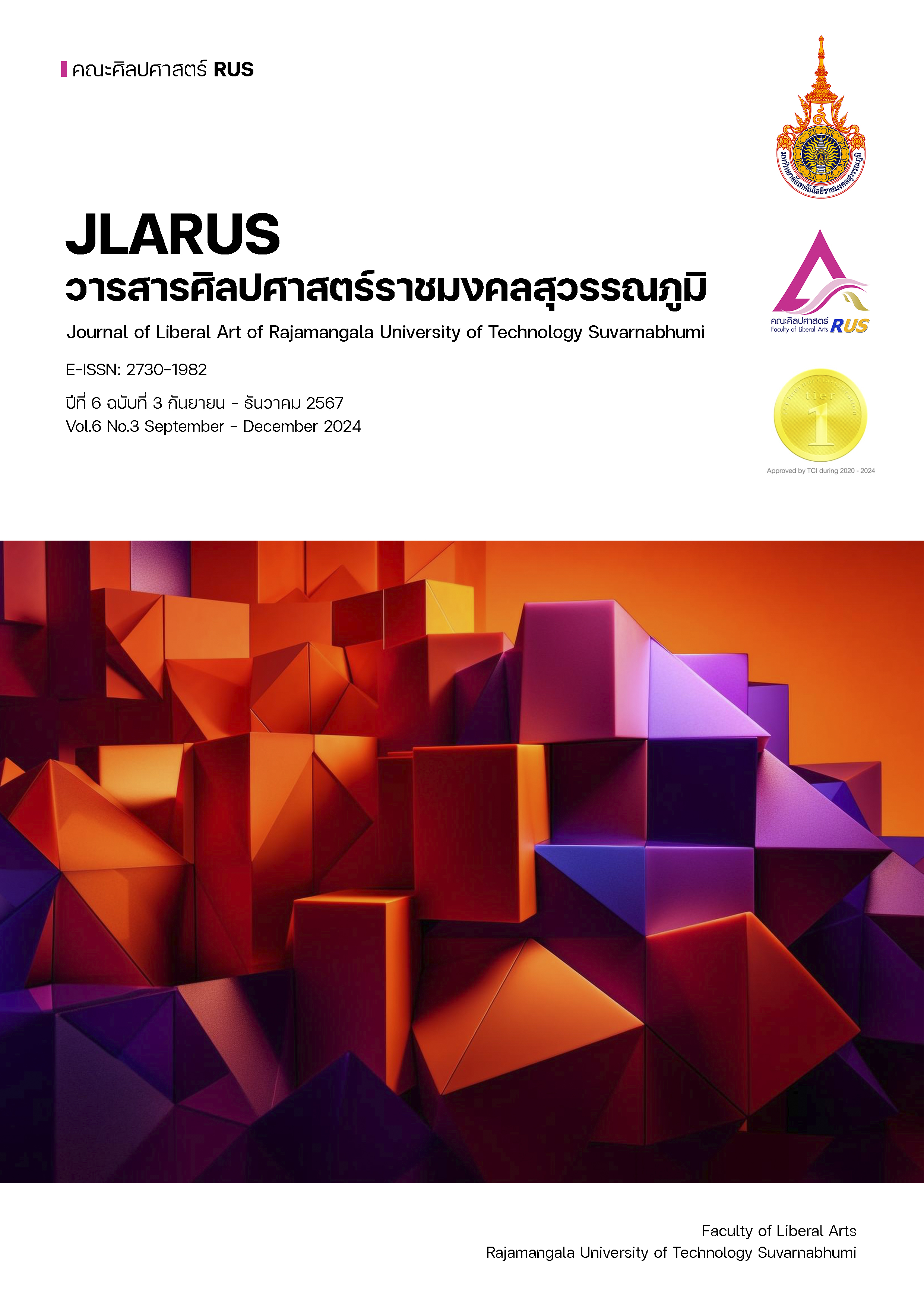WORKING CAPITAL POLICY CLUSTERING TECHNIQUE: A CASE STUDY OF LISTED COMPANIES IN THE INDUSTRIAL SECTOR, MAI THAILAND
Main Article Content
Abstract
Working capital policy (WCP) has an impact on liquidity and profitability management. An aggressive WCP allows businesses to generate profits from short-term capital sources but poses risks in timely short-term debt repayment. Determination of WCP involves various factors. Previous studies found that the risk level of the working capital policy is solely determined by the financial ratio, overlooking other contributing factors. This research aimed to enhance the coverage of risk dimensions in setting the risk level of WCP by introducing a clustering technique to determine the WCP risk level. The study population consisted of 213 companies listed on the Market for Alternative Investment (MAI). A specific sampling method was employed, focusing on companies within the industrial sector registered on the MAI. This study utilized panel data by gathering financial ratio data from the STATA database and executive position data (CEO, President) through the annual report Form 56-2 from the SEC database. Data collection spanned 15 consecutive years, from 2008 to 2022, divided into two periods: the COVID-19 pandemic outbreak and the non-pandemic period, which resulted in a total of 432 observations. The hierarchical clustering analysis technique was utilized, followed by K-means cluster analysis and one-way ANOVA robustness checks. The results revealed that the working capital investment policy (WCIP) could be categorized into three sub-groups: risky, moderate, and conservative. The working capital financing policy (WCFP) could be classified into two sub-groups: risky and conservative. K-means clustering analysis for risk levels identified two groups: a risky and a conservative WCP. One-way ANOVA analysis for group differentiation indicated three sub-groups for both policies.
Article Details

This work is licensed under a Creative Commons Attribution-NonCommercial-NoDerivatives 4.0 International License.
References
Adam, A. M., Quansah, E., & Kawor, S. (2017). Working Capital Management Policy and Return of Listed Manufacturing Firms in Ghana. Scientific Annals of Economics and Business, 64(2), 255-269.
Banchuenvijit, W. (2017). Working capital management and profitability of SMEs in Thailand. UTCC International Journal of Business and Economics, 9(2), 155-165.
Baños-Caballero, S., García-Teruel, P. J., & Martínez-Solano, P. (2020). Net operating working capital and firm value: A cross-country analysis. Business Research Quarterly, 23(3), 234-251.
Berk, J., DeMarzo, P., & Harford, J. (2009). Fundamentals of Corporate Finance. Pearson Education Inc.
Brigham, E. F., & Daves, P. R. (2007). Intermediate Financial Management. (9 ed.). USA: Thomson Learning.
Brigham, E. F., & Houston, J. F. (1998). Fundamentals of Financial Management. (8 ed.). Harcourt Inc.
Chancharat, S., & Chancharat, N. (2019). Board Structure, Ownership Structure, and Performance of Thai Listed Companies. Australasian Accounting, Business and Finance Journal, 13(3), 53-70.
Gupta, E., Gupta, E., & Mishra, A. (2011). Research Paper on Cluster Techniques of Data Variations. International Journal of Advance Technology & Engineering Research, 1(1), 39-47.
Intara, P., & Wanganusorn, B. (2022). The Relationship between Working Capital Management Efficiency and Financial Performance: The Case of Listed Companies in Agro and Food Industry in Thailand. Economics and Business Administration Journal, Thaksin University, 15(4), 73-92.
Kasiran, F. W., Mohamad, N. A., & Chin, O. (2016). Working Capital Management Efficiency: A Study on the Small Medium Enterprise in Malaysia. Procedia Economics and Finance, 35, 297-303.
Chancharat, N., & Kumpamool, C. (2022). Working capital management, board structure and Tobin's q ratio of Thai listed firms. Managerial Finance, 48(4), 541-556.
Mansoori, E., & Muhammad, J. D. (2012). The Effect of Working Capital Management on Firm's Profitability: Evidence from Singapore. Interdisciplinary Journal of Contemporary Research in Business, 4(5), 472-486.
McLachlan, G. J. (1992). Cluster analysis and related techniques in medical research. Stat Methods Med Res, 1(1), 27-48.
Myers, S. C., & Majluf, N. S. (1984). Corporate financing and investment decisions when firms have information that investors do not have. Journal of Financial Economics, 13(2), 187-221.
Nazir, M. S., & Afza, T. (2009). Working Capital Requirements and the Determining Factors in Pakistan. The ICFAI Journal of Applied Finance, 15(4), 28-38.
Pestonji, C., & Donkwa, K. (2018). Profitability of Food and Beverage Sector in the Thailand Stock Exchange. Journal of Accountancy and Management Mahasarakham Business School, Mahasarakham University, 10(2), 42-55.
Pestonji, C., & Wichitsatian, S. (2019). Determinants of Working Capital Management Impacting on Profitability: Evidence from Agro and Food Industry in Stock Exchange of Thailand. Suranaree Journal of Social Science, 13(1), 89-104.
Phromsuwansiri, B., Chutimagul, W., & Promnurakkij, S. (2022). Working Capital Management Policies Affecting Profitability and Sustainable Growth Rate of the Listed Companies on the Market for Alternative Investment (MAI). Journal of Innovation and Management, 7(2),46-60.
Punj, G., & Stewart, D. W. (1983). Cluster Analysis in Marketing Research: Review and Suggestions for Application. Journal of Marketing Research, 20(2), 134-148.
Raheman, A., Afza, T., Qayyum, A., & Bodla, M. A. (2010). Working Capital Management and Corporate Performance of Manufacturing Sector in Pakistan. International Research Journal of Finance and Economics, (47), 151-163.
Saunders, J. A. (1980). Cluster Analysis for Market Segmentation. European Journal of Marketing, 14(7), 422-435.
SET. (2023). the market for alternative investment. The Stock Exchange of Thailand. Retrieved October 29, 2023 from https://shorturl.at/3uuTH.
Sharma, A., Boroevich, K. A., Shigemizu, D., Kamatani, Y., Kubo, M., & Tsunoda, T. (2017). Hierarchical Maximum Likelihood Clustering Approach. IEEE Trans Biomed Eng, 64(1), 112-122.
Song, Z., Liu, D., & Chen, S. (2012). A Decision Engineering Method to Identify the Competitive Effects of Working Capital: A Neural Network Model. SciVerse ScienceDirect, 5, 326-333.
Sudiyatno, B., & Elen Puspitasari, S. S. (2017). Working Capital, Firm Performance, and Firm Value: An Empirical Study in Manufacturing Industry on Indonesia Stock Exchange. Economics, 5(5), 444-450.
Vishnani, S., & Shah, B. K. (2007). Impact of working capital management policies on corporate performance-an empirical study. Global Business Review, 8(2), 267-281.
Wanichbancha, K. (2009). Statistics for research. (4 ed.). Bangkok: Book Center of Chulalongkorn.


